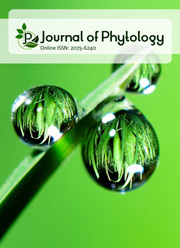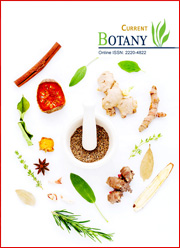Chemical composition and antioxidant activity of acetone extract from Chlorophytum laxum
DOI:
https://doi.org/10.25081/jp.2025.v17.9235Keywords:
Chlorophytum laxum, Acetone extract, Antioxidant activity, Phytochemistry, GC-MSAbstract
The genus Chlorophytum is renowned for its ornamental value and applications in traditional medicine, especially in tropical regions. This study presents the first report on the phytochemical screening, volatile compound profiling, and antioxidant activity of acetone extracts from the leaves and roots of Chlorophytum laxum. Gas chromatography-mass spectrometry (GC-MS) analysis revealed 34 and 22 volatile compounds in the leaf and root extracts, respectively. In the leaf extract, the major components identified were 2-pentanone, 4-methoxy-4-methyl-; 1,2,4-butanetriol; 9,12,15-octadecatrienoic acid, (Z,Z,Z)-; n-hexadecanoic acid; neophytadiene; and 5-hydroxymethylfurfural. Conversely, the root extract predominantly contained 2-pentanone, 4-hydroxy-4-methyl-, and 5-hydroxymethylfurfural. Furthermore, the antioxidant capacity was evaluated using the ABTS radical scavenging assay. The leaf and root acetone extracts exhibited IC50 values of 29.82±1.08 μg/mL and 52.46±2.51 μg/mL, respectively. These findings suggest potential applications for C. laxum in pharmaceutical and food industries and warrant further investigation into its bioactive properties and potential utilization.
Downloads
References
Abubakar, A., Nazifi, A. B., Maje, I. M., Tanko, Y., Anuka, J. A., & Abdurahman, E. M. (2021). Antihyperglycaemic activity of ethylacetate extract of Chlorophytum alismifolium in type 2 diabetes: The involvement of peroxisome proliferator-activated receptor-γ and dipeptidyl peptidase-4. Journal of Integrative Medicine, 19(1), 78-84. https://doi.org/10.1016/j.joim.2020.10.008
Abubakar, A., Nazifi, A. B., Odoma, S., Shehu, S., & Danjuma, N. M. (2020). Antinociceptive activity of methanol extract of Chlorophytum alismifolium tubers in murine model of pain: Possible involvement of α2-adrenergic receptor and KATP channels. Journal of Traditional and Complementary Medicine, 10(1), 1-6. https://doi.org/10.1016/j.jtcme.2019.03.005
Adhami, S., Farooqi, H., Abdin, M. Z., Prasad, R., & Malik, A. A. (2021). Chemical profiling of Chlorophytum comosum (Thunb.) Jaques by GC-MS/LC-ESIMS and its antiproliferative effects on human carcinoma cell lines. Anti-Cancer Agents in Medicinal Chemistry, 21(13), 1697-1707. https://doi.org/10.2174/1871520620666201123085300
Arundhathy, G. B., & Suja, S. R. (2018). Assessment of antiinflammatory properties of Chlorophytum laxum R. Br. International Journal of Advance Research, Ideas and Innovations in Technology, 4(5), 194-200.
Bodi, D., Ronczka, S., Gottschalk, C., Behr, N., Skibba, A., Wagner, M., Lahrssen-Wiederholt, M., Preiss-Weigert, A., & These, A. (2014). Determination of pyrrolizidine alkaloids in tea, herbal drugs, and honey. Food Additives and Contaminants: Part A, 31(11), 1886-1895. https://doi.org/10.1080/19440049.2014.964337
Chakraborthy, G. S., Aeri, V., Verma, P., & Singh, S. (2014). Phytochemical and antimicrobial studies of Chlorophytum borivilianum. Pharmacophore, 5(2), 258-261.
Chao, F., Jin, H., Wu, L., Zhang, Y., Ye, R. D., Zhang, W., & Zhang, Y. (2017). An exploration of traditional Chinese medicinal plants with anti-inflammatory activities. Evidence-Based Complementary and Alternative Medicine, 2017(1), 1231820. https://doi.org/10.1155/2017/1231820
Chittama, K. P., Deoreb, S. L., & Deshmukh, T. A. (2016). Free radical scavenging activity of plant extracts of Chlorophytum tuberosum B. Der Pharmacia Lettre, 8(8), 308-312.
Dabur, R., Gupta, A., Mandal, T. K., Singh, D. D., Bajpai, V., Gurav, A. M., & Lavekar, G. S. (2007). Antimicrobial activity of some Indian medicinal plants. African Journal of Traditional, Complementary and Alternative Medicines, 4(3), 313-318. https://doi.org/10.4314/ajtcam.v4i3.31225
Deka, A. C., Sarma, I., Dey, S., & Sarma, T. C. (2017). Antimicrobial properties and phytochemical screening of some wild macrofungi of Rani-Garbhanga reserve forest area of Assam, India. Advances in Applied Science Research, 8(3), 17-22.
Deore, S. L., Jajoo, N. B., Chittam, K. P., & Deshmukh, T. A. (2015). Comparative pharmacognostic, phytochemical and biological evaluation between five Chlorophytum species. Pharmacognosy Journal, 7(5), 317-325. https://doi.org/10.5530/pj.2015.5.12
Ganesan, T., Subban, M., Leslee, D. B. C., Kuppannan, S. B., & Seedevi, P. (2022). Structural characterization of n-hexadecanoic acid from the leaves of Ipomoea eriocarpa and its antioxidant and antibacterial activities. Biomass Conversion and Biorefinery, 14, 14547-14558. https://doi.org/10.1007/s13399-022-03576-w
Giribabu, N., Kumar, K. E., Rekha, S. S., Muniandy, S., & Salleh, N. (2014a). Chlorophytum borivilianum (Safed Musli) root extract prevents impairment in characteristics and elevation of oxidative stress in sperm of streptozotocin-induced adult male diabetic Wistar rats. BMC Complementary and Aternative Medicine, 14, 291. https://doi.org/10.1186/1472-6882-14-291
Giribabu, N., Kumar, K. E., Rekha, S. S., Muniandy, S., & Salleh, N. (2014b). Chlorophytum borivilianum root extract maintains near normal blood glucose, insulin and lipid profile levels and prevents oxidative stress in the pancreas of streptozotocin-induced adult male diabetic rats. International Journal of Medical Sciences, 11(11), 1172-1184. https://doi.org/10.7150/ijms.9056
Katoch, M., Kumar, R., Pal, S., & Ahuja, A. (2010). Identification of Chlorophytum species (C. borivilianum, C. arundinaceum, C. laxum, C. capense, and C. comosum) using molecular markers. Industrial Crops and Products, 32(3), 389-393. https://doi.org/10.1016/j.indcrop.2010.06.001
Kaushik, N. (2005). Saponins of Chlorophytum species. Phytochemistry Reviews, 4, 191-196. https://doi.org/10.1007/s11101-005-2607-5
Kavya, P., Theijeswini, R. C., & Gayathri, M. (2024). Phytochemical analysis, identification of bioactive compounds using GC-MS, in vitro and in silico hypoglycemic potential, in vitro antioxidant potential, and in silico ADME analysis of Chlorophytum comosum root and leaf. Frontiers in Chemistry, 12, 1458505.
Khan, T., Shah, S. M., Khan, S. A., Hassan, A., Khan, A. R., Akhtar, G., Imtiaz, H., & Sajjad, Y. (2023). Evaluating the antioxidative defense response of selected indoor plants against benzene and formaldehyde. Environmental Science and Pollution Research, 30, 99273-99283. https://doi.org/10.1007/s11356-023-28166-9
Kumar, M., Meena, P., Verma, S., Kumar, M., & Kumar, A. (2010). Anti-tumour, anti-mutagenic and chemomodulatory potential of Chlorophytum borivilianum. Asian Pacific Journal of Cancer Prevention, 11, 327-334.
Li, J., Zhong, J., Liu, Q., Yang, H., Wang, Z., Li, Y., Zhang, W., & Agranovski, I. (2021). Indoor formaldehyde removal by three species of Chlorophytum comosum under dynamic fumigation system: part 2—plant recovery. Environmental Science and Pollution Research, 28, 8453-8465. https://doi.org/10.1007/s11356-020-11167-3
Li, X.-C., Wang, D.-Z., & Yang, C.-R. (1990). Steroidal saponins from Chlorophytum malayense. Phytochemistry, 29(12), 3893-3898. https://doi.org/10.1016/0031-9422(90)85354-I
Llauradó, G., Morris, H. J., Lebeque, Y., Gutiérrez, A., Fontaine, R., Bermúdez, R. C., & Perraud-Gaime, I. (2013). Phytochemical screening and effects on cell-mediated immune response of Pleurotus fruiting bodies powder. Food and Agricultural Immunology, 24(3), 295-304. https://doi.org/10.1080/09540105.2012.686988
Maeng, J.-H., Shahbaz, H. M., Ameer, K., Jo, Y., & Kwon, J.-H. (2017). Optimization of microwave‐assisted extraction of bioactive compounds from Coriolus versicolor mushroom using response surface methodology. Journal of Food Process Engineering, 40(2), e12421. https://doi.org/10.1111/jfpe.12421
Mararajah, S., Giribabu, N., & Salleh, N. (2024). Chlorophytum borivilianum aqueous root extract prevents deterioration of testicular function in mice and preserves human sperm function in hydrogen peroxide (H2O2)-induced oxidative stress. Journal of Ethnopharmacology, 318, 117026. https://doi.org/10.1016/j.jep.2023.117026
Ngan, V. T. K., Hoang, N. T., Duc, T. H., Do, N. D., & Mai, N. T. N. (2017). Determination of total phenolic and flavonoid content, antioxidant and antibacterial activities of ethanolic and methanolic extracts of Imperata cylindrica rhizomes and leaves. Can Tho University Journal of Science, 52, 16-22. https://doi.org/10.22144/ctu.jvn.2017.119
Nguyen, D. D., Vo, N. T., Nguyen, V. B., Phan, T. K., Nguyen, T. T., & Huynh, N. T. T. (2017). Investigation on biochemical properties and antibacterial ability of extracts from sweet taro (Colocasia esculenta). Huaf Journal of Agricultural Science and Technology, 1(2), 265-274.
O’Donnell, G., Bucar, F., & Gibbons, S. (2006). Phytochemistry and antimycobacterial activity of Chlorophytum inornatum. Phytochemistry, 67(2), 178-182. https://doi.org/10.1016/j.phytochem.2005.10.023
Odebiyi, O. O., & Sofowora, E. A. (1978). Phytochemical screening of Nigerian medicinal plants II. Lloydia, 41(3), 234-246.
Padayachee, B., Odun-Ayo, F., & Reddy, L. (2021). Apoptotic effect of Bulbine natalensis and Chlorophytum comosum in myelogenous Leukemia K562 cell line. Brazilian Journal of Biology, 84, e251336. https://doi.org/10.1590/1519-6984.251336
Rzhepakovsky, I. V., Areshidze, D. A., Avanesyan, S. S., Grimm, W. D., Filatova, N. V., Kalinin, A. V., Kochergin, S. G., Kozlova, M. A., Kurchenko, V. P., Sizonenko, M. N., Terentiev, A. A., Timchenko, L. D., Trigub, M. M., Nagdalian, A. A., & Piskov, S. (2022). Phytochemical characterization, antioxidant activity, and cytotoxicity of methanolic leaf extract of Chlorophytum comosum (Green type)(Thunb.) Jacq. Molecules, 27(3), 762. https://doi.org/10.3390/molecules27030762
Sharma, R. R., & Thakare, P. V. (2019). Pharmacognostical study of medicinal plants of Western Ghats: Chlorophytum kolhapurens and Chlorophytum bharuchae. Journal of Pharmacognosy and Phytochemistry, 8(6), 26-29.
Ullah, A., Munir, S., Badshah, S. L., Khan, N., Ghani, L., Poulson, B. G., Emwas, A.-H., & Jaremko, M. (2020). Important flavonoids and their role as a therapeutic agent. Molecules, 25(22), 5243. https://doi.org/10.3390/molecules25225243
Vakele, Y., Odun-Ayo, F., & Reddy, L. (2022). In vitro antioxidant and cytotoxicity activities of selected indigenous South African medicinal plants. African Health Sciences, 22(1), 395-403. https://doi.org/10.4314/ahs.v22i1.48
Visavadiya, N. P., & Narasimhacharya, A. V. R. L. (2007). Ameliorative effect of Chlorophytum borivilianum root on lipid metabolism in hyperlipaemic rats. Clinical and Experimental Pharmacology and Physiology, 34(3), 244-249. https://doi.org/10.1111/j.1440-1681.2007.04579.x
Vyas, R., Kesari, K. K., Slama, P., Roychoudhury, S., & Sisodia, R. (2022). Differential activity of antioxidants in testicular tissues following administration of Chlorophytum borivilianum in gamma-irradiated Swiss albino mice. Frontiers in Pharmacology, 12, 774444. https://doi.org/10.3389/fphar.2021.774444
Zhao, L., Chen, J., Su, J., Li, L., Hu, S., Li, B., Zhang, X., Xu, Z., & Chen, T. (2013). In vitro antioxidant and antiproliferative activities of 5-hydroxymethylfurfural. Journal of Agricultural and Food Chemistry, 61(44), 10604-10611. https://doi.org/10.1021/jf403098y
Published
How to Cite
Issue
Section
Copyright (c) 2025 Hanh Thi Dieu Nguyen, Duc Hoa Nguyen, Thanh Dat Ngo, Ngoc An Nguyen, Ngoc Thuan Nguyen, Quoc Hung Nguyen, Tan Viet Pham

This work is licensed under a Creative Commons Attribution 4.0 International License.





 .
.